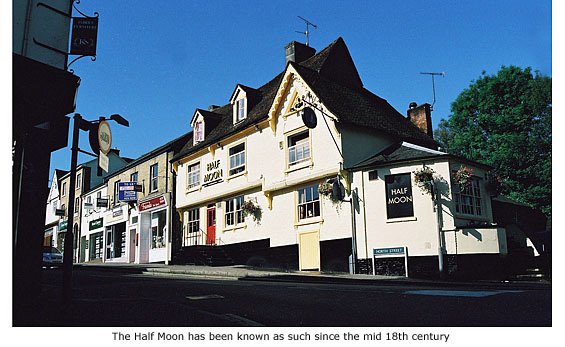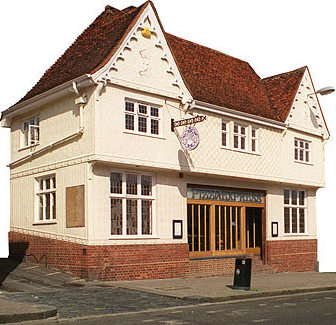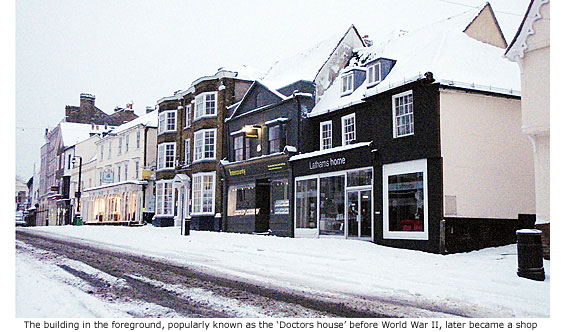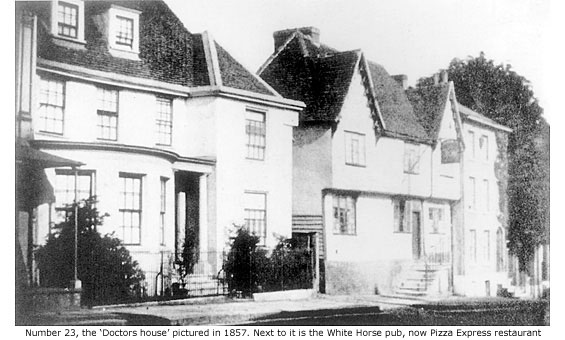|

 This inn began its life around 1642 in premises a few doors away where No 27 now stands next to the former White Horse Inn. Its popularity and importance at that time is confirmed by the fact that it issued its own trading tokens in 1666, each being worth one farthing (See Guide 2 - Trading Tokens). This inn began its life around 1642 in premises a few doors away where No 27 now stands next to the former White Horse Inn. Its popularity and importance at that time is confirmed by the fact that it issued its own trading tokens in 1666, each being worth one farthing (See Guide 2 - Trading Tokens).
The inn also traded under different names on its original site, churchwardens’ accounts of 1681 revealing that Thomas Markwell paid 3d. (2 1/2p) rent ‘for the halfe Moone in North Street’, and a reference to it in 1736 stating ‘formerly the White Swan and now the Green Man.' The current name probably stems from 1752 when it moved to this site – a reference in 1767 stating ‘formerly the Green Man and now the Half Moon.'
It was around this time that Bishop’s Stortford’s cattle market (then based in North Street) was described as the 'finest in East Anglia', making the Half Moon a regular and lively venue for both traders and farmers each and every Thursday. But the inn's popularity didn’t last, because in 1789 the owner went bankrupt. Local brewery Hawkes then bought the property and finally got round to renovating it one hundred years later. The building's brick exterior was then covered with a cement and shingle render, but during this process the original construction date (1638) on the front gable was also covered over. What purpose the building served between 1638 and 1752 isn’t known but it is likely to have been a private house. Hawkes Brewery held the inn until they were taken over by Benskins Brewery in 1898.
Inevitably the Half Moon's interior has also been altered and renovated through the years and in 1994 an attempt was made to modernise the pub's image by renaming it the Tap and Spile. Thankfully the name was shortlived and its traditional title reinstated in 1999.
In the 1960s Bishop’s Stortford was noted as a centre for Blues music, but as the public's taste in music changed so too did the local clubs in which it was played. Consequently, Blues music died an untimely death. But, what goes around usually comes around again. A revival of Blues music in the early 1990s led to the Half Moon becoming permanent host to the Bishops Blues Club, and since 1994 has been ‘the’ venue for staging high quality acts from Britain, America and Europe.
Music is performed in the ‘Long Room’, a self contained area at the rear of the pub complete with stage and bar, and every week there is either a gig by a visiting band or solo artist, and/or a jam session performed by local musicians. This is certainly not a ‘purist’ environment though. All forms of Blues music from traditional to modern re-interpretations are played and the idea of the club is just to appreciate and have fun.
Formal membership is not required as anyone who can play or who enjoys Blues music is welcome. It is advisable to turn up early though. www.bluesalive.co.uk
No 27: Original site of the Half Moon public house (See No 31) and entrance to Watson's poultry market before it moved to Hadham Road (See Guide 5 – Hadham Road) MORE PICTURES
|
|
 Currently a modern restaurant but once the White Horse Inn, this is, arguably, the finest building in North Street. The modern rendered exterior with pargetting decoration covers a timber and plaster framework thought to have been constructed around 1550, and its history can be traced back to 1572. An inn for more than 300 years it has since undergone much renovation and alteration, especially inside, but externally looks much as it did when built. Currently a modern restaurant but once the White Horse Inn, this is, arguably, the finest building in North Street. The modern rendered exterior with pargetting decoration covers a timber and plaster framework thought to have been constructed around 1550, and its history can be traced back to 1572. An inn for more than 300 years it has since undergone much renovation and alteration, especially inside, but externally looks much as it did when built.
John Janfield was the property's first recorded owner in 1572 (then probably a private house), while in 1681 churchwardens’ accounts record 'received of Edward Thurgood for the White Horse in North Street, 6d.' Future landlords came and went and in 1858 it was run by John Parish, whose fourth daughter, Ellen, married Walter Gilbey that same year (See Guide 2 – Walter Gilbey).
Like most of the town's inns and public houses in the 19th century the White Horse was eventually taken over by Hawkes brewery, then later Benskins who sold the property at auction in April 1921. The auction sale description of the building (HALS REF: D/ETE B184) is as follows:
Ground floor: 3 front sitting rooms, entrance hall and kitchen.
First floor: by staircase, 5 bedrooms and open gallery for overlooking the yard.
Basement: cellars, water and gas laid on.
Timber and tiled outbuilding: lower floor a room 52ft x 14ft formerly used as an armoury with a room over, now used as a Band room.
Timber tiled slaughter house
Four-stall stables with harness room and loft
Loose box two-stalled stable and iron roofed chaise house
Yard: well with pump.
The White Horse finally closed in 1936 to become a shop owned by the Northmet Electricity Company and has since had many and various owners. Conversion to the current restaurant in the 1990s entailed making both the upstairs and downstairs open-plan, thus losing much of its former character. That said, it's still worth the price of a meal here just to sit and take in the building's history and view North Street from its lattice windows.
White Horse Yard at the rear of the building has over the years been home to a small brewery, a poultry and rabbit market, a slaughterhouse, and the inn's stables – all long since replaced by modern development. In 1910 Carriers regularly left the White Horse Inn for Albury and Little Hadham. MORE PICTURES
|
|
This 17th century building's original ‘L’ shaped frontage is disguised at ground level by structural alterations and large shop windows. Before conversion in the mid 1900s the house displayed an elegant pillared porch entrance, large round-bay window and, like many of the buildings along this stretch of road, a small front garden bordered by iron railings. This was removed in the late 1930s to make the pavement wider; the thin strip of concrete visible in front of the shop marking the garden's original boundary.
The building has always been known as the ‘Doctors House’, the earliest recorded practioner being Dr James Tweed. And between 1733 and 1814 it was the family home and surgery of the Dimsdales – a Quaker family of doctors who practised in both Bishop’s Stortford and Hertford during the 17th, 18th and early 19th century (See Guide 14). Robert Dimsdale MD was the last family member to practise in Stortford. He died in December 1814, aged 81, just 3 months after his wife Elizabeth, aged 74. Their son, Robert, died in 1832, aged 61. All are buried in St Michael's churchyard.
Resident in 1841 was Dr Henry Cribb, surgeon. He was joined in 1845 by Charles Frederick Hodson of the Chantry and in 1867 by Charles's son, William. Nephew Henry Cribb, surgeon and GP, continued the practice until 1871. In residence from 1894–1929 was Dr Agnew. He was joined by Dr Hartley in 1901, and in 1915 Doctors' Agnew, Dockray and Newman all practised here. Entrance to their surgeries was through a door in the high brick wall at the side of the building.
Between 1929 and 1938 this property was home and surgery to Dr Robert Aller Rotherham Wallace MB ChM (Sydney), an Australian by birth (1888–1980). His mother was English and his father a distinguished Australian soldier of Scottish descent. He died in Melbourne in 1915.
When Dr Wallace moved to England is unknown but in the early 1920s he practised in Buckden, Cambridgeshire. At some stage his mother also came to England and is recorded as living for a time in Huntingdon. In May 1924, The Times announced his engagement to Nancy Maule, but a few months later announced that Miss Maule was now engaged to an officer of the Royal Tank Corps. By 1926, Dr Wallace was practising in London and from 1929 onwards practised in Bishop's Stortford.
He was by all accounts a popular and dependable man and one of life's rare characters: he rode a motorbike in a happy-go-lucky manner, went rat shooting, and kept ferrets in his surgery. In 1938 he moved to nearby Hadham Road where he continued his practice, and for the duration of the Second World War (1939–1945) is said to have been the only regular surgeon on call at local Haymeads Hospital.
In 1966 he wrote to the British Medical Journal to explain how he had undertaken over 15,000 successful tonsillectomies in his career (some carried out on the patient's own kitchen table), but refrained to mention that this figure including taking out his own tonsils with the aid of a mirror.
Dr Wallace continued his practice at Hadham Road until retirement in 1969, and died in 1980, aged 92. His name lives on in Bishop's Stortford in the street name, Robert Wallace Close.
*My thanks to Mike Storey for added information about Dr Wallace. MORE PICTURES
|





 This inn began its life around 1642 in premises a few doors away where No 27 now stands next to the former White Horse Inn. Its popularity and importance at that time is confirmed by the fact that it issued its own trading tokens in 1666, each being worth one farthing (See Guide 2 - Trading Tokens).
This inn began its life around 1642 in premises a few doors away where No 27 now stands next to the former White Horse Inn. Its popularity and importance at that time is confirmed by the fact that it issued its own trading tokens in 1666, each being worth one farthing (See Guide 2 - Trading Tokens). Currently a modern restaurant but once the White Horse Inn, this is, arguably, the finest building in North Street. The modern rendered exterior with pargetting decoration covers a timber and plaster framework thought to have been constructed around 1550, and its history can be traced back to 1572. An inn for more than 300 years it has since undergone much renovation and alteration, especially inside, but externally looks much as it did when built.
Currently a modern restaurant but once the White Horse Inn, this is, arguably, the finest building in North Street. The modern rendered exterior with pargetting decoration covers a timber and plaster framework thought to have been constructed around 1550, and its history can be traced back to 1572. An inn for more than 300 years it has since undergone much renovation and alteration, especially inside, but externally looks much as it did when built.